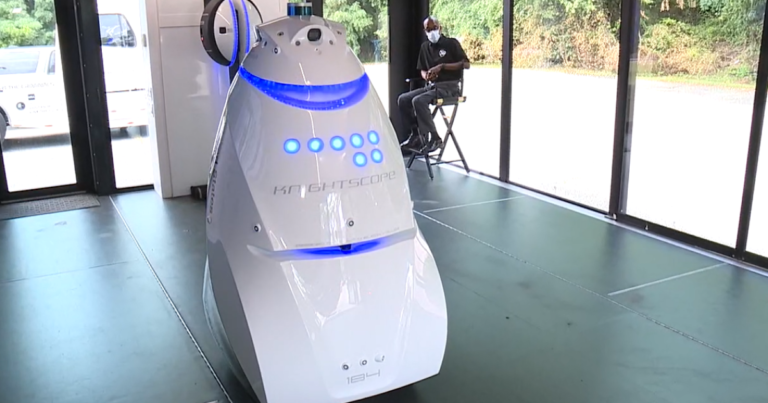BALTIMORE, Maryland — Crime-fighting robots roam the streets? No, this isn’t the stuff of science fiction, but a real-life application of artificial intelligence that’s being used in hotels, casinos, shopping malls and police stations.
“Three words: deter, detect and report,” Mark Santana Lee, co-founder of Knightscope, the company that makes the robots, told a group of about two dozen people who had gathered at Baltimore’s Northside Baptist Church to learn about the technology.
You can see the robot in action in the video above from the 6pm newscast.
Baltimore-based technology company X9 Intelligence sells Knightscope products and hopes to have the Baltimore Police Department on board as a customer. The companies briefed the public on the benefits of the technology on Friday.

“We’re not trying to replace humans with our technology. All of our technologies are designed to assist and enhance humans,” Lee told the audience. “We want to be additional eyes, ears and voices for humans.”
I know what you’re thinking: “How do we stop someone from trying to vandalize this?” Police can actually assign robots to act as police deputies, so attacking a robot would be the same as assaulting a police officer.
“The robot has 360-degree vision, so if you go up and want to just hit it, it weighs 420 pounds, so you’re going to see it first,” Carroll said.
These bots are not completely independent: the cameras are constantly monitored by humans.
“If something seems unusual, an alarm goes off and someone decides what to do next,” explained Jonathan Carroll, head of X9 Intelligence.
Carroll demonstrated how the robot works to a group of curious onlookers.

“Let’s say K5 is in Druid Hill Park. It’s on patrol. A resident is having some kind of emergency. They may feel unsafe or they may be having a medical emergency. When they press the security call button, it automatically connects them to an officer on the handler side who can talk to them and get them immediate help. That way, they don’t feel like they’re alone,” Carroll said, demonstrating the robot’s call button. “If someone can’t press the button, they can just stand in front of the robot and wave their hands and say, ‘Help me, help me,’ and the handler on the back end will see that and make contact with that person.”

Police could also turn on facial recognition and program a list of wanted criminals into the robot.
“You give it a list of suspects, and if the robot sees someone who matches someone on that list, it will alert a handler. A human then has to verify the match,” Carroll told the group. “If there’s a need for customization, for example if the robot is going to be a church security guard and the pastor wants to only allow certain people into the church after hours, the facial recognition feature can be enabled for just those people. Rather than opening up the facial recognition to the public, it just captures people’s faces.”
Facial recognition and listening features can also be disabled by individual clients if they wish.
“We don’t record audio unless someone presses the intercom button and is in trouble. We announce that we’re recording. Video, on the other hand, is streamed 24/7,” co-founder Stacey Stevens told the venue via a Zoom call. “By law, you can’t eavesdrop on private conversations. You can’t put a robot in a place where you have an expectation of privacy. If you’re in a public place, you can’t have an expectation of privacy. Hotel rooms, conference rooms, bathrooms, etc. are private places.”
Footage is stored by Knightscope and automatically deleted after 30 days unless law enforcement needs to preserve it as evidence.
The biggest concern of Baltimore residents who came to see the robot in action was privacy.
“I’m a little skeptical,” Herbert Johnson told WMAR-2 News’ Elizabeth Worthington, “I like the idea that they’re trying to make it a better environment, but I’m a little skeptical about whether they’re going to be able to store information that a person out on the street might not want given to them or kept.”
“I think it’s great. Like a lot of other people, we were really concerned about how invasive it would be, and a lot of people may still have those concerns, but I think AI can really go a long way in terms of reducing crime,” Baltimore resident Orlester Shaw said. “Honestly, AI is here, invasive or not, so we’re using it to our advantage and reducing crime is definitely a priority, or it should be.”
Prices vary depending on the client, typically $10-12 per hour for an annual contract, and slightly more for shorter engagements such as one-day events.
Carroll said X9 Intelligence has been in contact with BPD but couldn’t comment on whether the department has expressed interest. A BPD spokesman also couldn’t confirm whether the agency was considering the possibility.
The technology has been deployed in other cities with mixed results.
In Las Vegas, a crime-ridden apartment complex began using one of Knightscope’s “crime-fighting robots” in 2021 and saw a drop in 911 calls.
But in New York City, the NYPD conducted a trial of the robots in the Times Square subway station, paying for a six-month contract, but after just two months they were taken out of service and put into storage, for reasons that were not disclosed, and the technology has come under fire.


